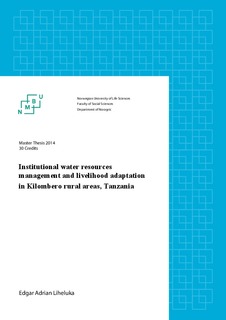| dc.contributor.author | Liheluka, Edgar Adrian | |
| dc.date.accessioned | 2014-09-18T09:20:11Z | |
| dc.date.available | 2014-09-18T09:20:11Z | |
| dc.date.copyright | 2014 | |
| dc.date.issued | 2014-09-18 | |
| dc.identifier.uri | http://hdl.handle.net/11250/220409 | |
| dc.description.abstract | This study attempts to understand institutional water resource management in irrigation schemes and its implication on livelihood activities in two study villages in Kilombero District, Tanzania. Mixed methods research was applied including both qualitative and quantitative research approaches. Ostrom’s design principles for long-enduring Common-Pool Resources (CPRs) are employed to evaluate irrigation schemes and its implications in smallholder farmers’ livelihoods. Sustainable Livelihood Approach (SLA) is brought from Ellis (2000) to analyze livelihoods and water dependence in the study villages. Design principles and SLA were used to analyze qualitative data and JMP statistical software was used to analyze quantitative data.
On-farm activities account for 77% of the household income in the total sample. Mkula and Msolwa A villages have 81% and 76% of on-farm income respectively. Rice and sugarcane are types of crops that constitute the major share of the household incomes. Non-farm (18%) off-farm activities (3%) and remittances (2%) have lower shares in the household income. Higher income families have ten times higher income compared to lower income families. Irrigation schemes yield higher returns compared to rain-fed agriculture. This is linked to water availability and access.
Land and water scarcity constrain agricultural activities in the villages. Land and water scarcity are linked to many variables including population growth per time, reduction of river flows, rainfall fluctuations, environmental pressure and similar reasons. Other limiting factors in agricultural activities include insufficient inputs access, inadequacy in farming practices, market infrastructure, lack of capitals, leveling problems in irrigation fields and other factors. Farmers applied various means to cope or adopt changes to secure livelihood outcomes. Capital diversification, renting out or selling properties, cultivating more than one crop, cultivating resilient crops, engage in wage labor, initiating rural trade and similar means are kinds of coping or adopting strategies applied by farmers in the villages.
We used an institutional water resource management assessment, following Ostrom’s design principles for long-enduring CPRs evaluation and found inadequacies in clearly assigning boundaries, water rights, fulfilling duties and responsibilities, water monitoring and sanction systems. Failures in institutional water resources arrangements in all levels together with poor irrigation infrastructure caused ineffectiveness in controlling and regulating water in the catchment points and in the distribution systems. However, at the village levels smallholder farmers reported to have a fair decision making process and there were absence of external interference on village affairs regarding water arrangements. Contestations of water use between upstream and downstream were however reported, mostly during water shortage periods (dry seasons, July to November).
The contribution of this study in practice based on the findings is that the State, various agencies, stakeholders, farmers and others should develop special attention to improve and develop irrigation projects in accessible areas because it yields sustainable livelihoods. Irrigation projects have increased productivity and provided much higher profits to the smallholder farmers in the study area. The agricultural sector employs a substantial share of Tanzanian’s population can be transformed and become more productive by improving and developing irrigation projects. This will help to improve rural livelihoods by increasing food security and poverty alleviation. It is also important to find ways to increase land productivity; to produce more with less land, less water and with more environmental focus, so we won’t be the last left living on this planet.
Knowledge gained in this study can be shared by interested parties in other parts in the country and elsewhere to understand the institutional managerial tasks in water resources and its implication in livelihoods. | nb_NO |
| dc.description.sponsorship | Self-sponsored and fieldwork by EPINAV Project which is sponsored by NORAD | nb_NO |
| dc.language.iso | eng | nb_NO |
| dc.publisher | Norwegian University of Life Sciences, Ås | |
| dc.rights | Attribution-ShareAlike 3.0 Norway | * |
| dc.rights.uri | http://creativecommons.org/licenses/by-sa/3.0/no/ | * |
| dc.subject | Water resources management, Livelihoods, Kilombero, Institutions, Tanzania | nb_NO |
| dc.title | Institutional water resources management and livelihood adaptation in Kilombero rural areasTanzania | nb_NO |
| dc.type | Master thesis | nb_NO |
| dc.subject.nsi | VDP::Social science: 200::Sociology: 220 | nb_NO |
| dc.subject.nsi | VDP::Technology: 500::Environmental engineering: 610 | nb_NO |
| dc.subject.nsi | VDP::Technology: 500::Building technology: 530::Hydrotechnology: 538 | nb_NO |
| dc.source.pagenumber | 162, XX | nb_NO |
| dc.description.localcode | M-IR | nb_NO |

